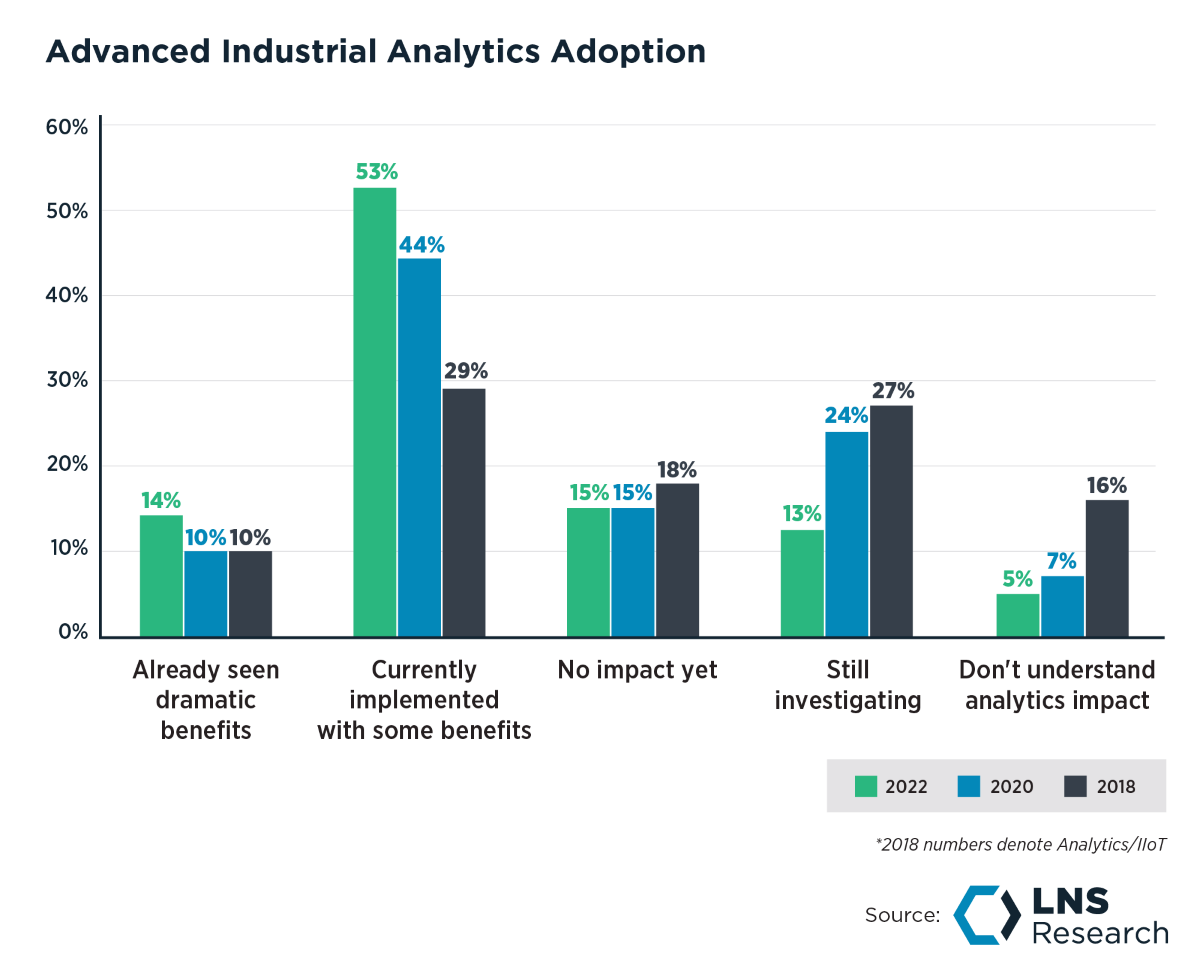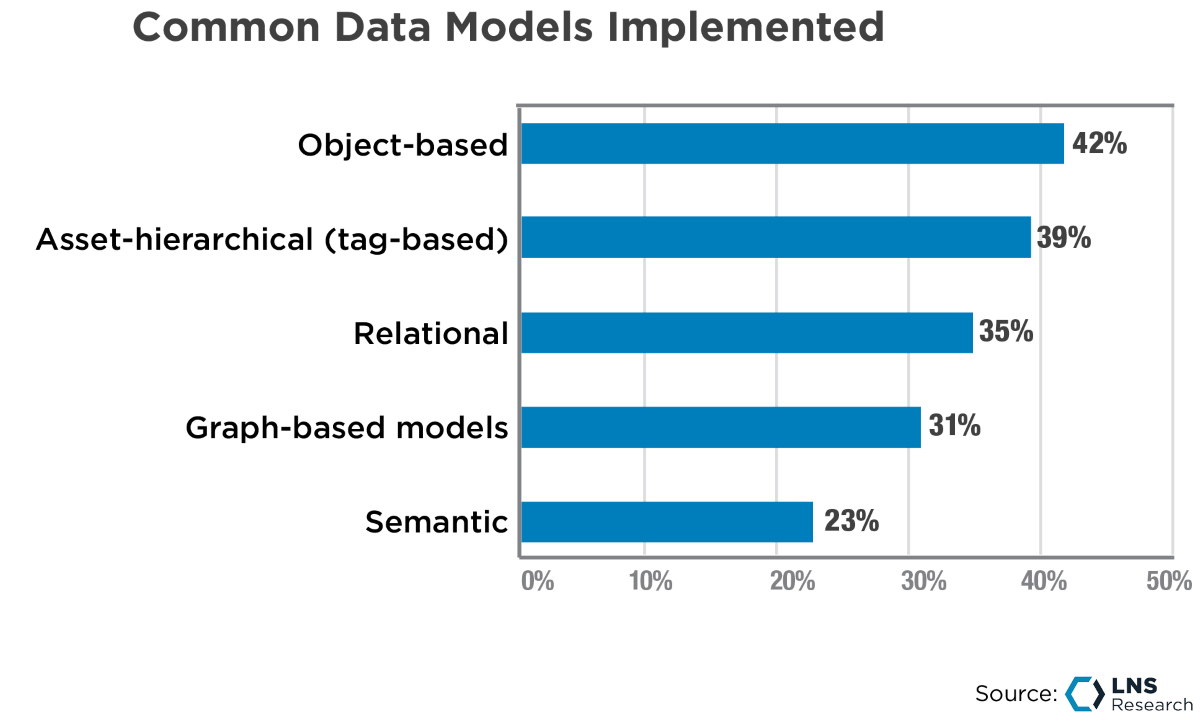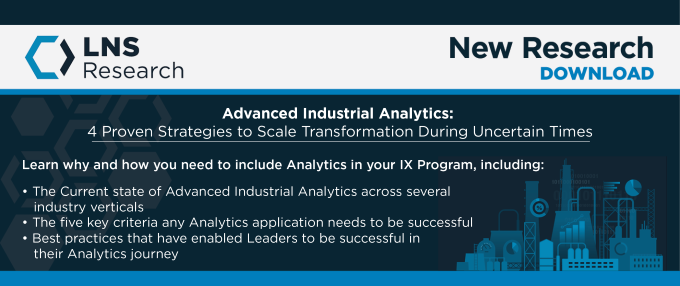On January 26, LNS Research hosted our first Executive Roundtable for 2023. The virtual event on the topic of Advanced Industrial Analytics was attended by over 25 senior executives from leading industrial companies like Pfizer, Cargill, Georgia Pacific, Raytheon Technologies, and Vertex Pharmaceuticals among many others.
The 90-minute interactive session began with the attendees describing their strategic initiatives and discussing common challenges, which included:
-
-
-
Next-gen automation at the factory floor and driving productivity gains,
-
Data readiness and bringing together multiple sources of data
-
Scaling and sustaining Analytics models through modern architecture.
After that introductory discussion, LNS Research began proceedings by sharing our recent Analytics That Matter research and highlighted five critical elements required to successfully scale Analytics. We then shifted gears to hear from our guest speaker Nick Drucker, Senior Director of Pratt & Whitney, on their Digital Transformation journey and how they leveraged analytics in building a model-based enterprise.
Running just a couple of minutes over time, we wrapped up the roundtable with some final questions, some of which are highlighted in this blog post.
#1: What are the dramatic benefits that Analytics Leaders have achieved?
The first question from the roundtable was from this data point where we categorized the top 14% of surveyed companies (in 2022) that have realized dramatic benefits as Analytics Leaders. LNS Research defines these “dramatic benefits” as step-change improvements in operational and financial metrics that can be scaled and sustained over time.

Readers should be aware that it typically takes companies several years to achieve these dramatic benefits. For example, one manufacturing company doubled its operating margins (from 10% to 20%) on a multi-billion-dollar revenue after a five-year transformation journey.
On the operational side, several companies that have implemented Analytics initiatives have seen dramatic benefits that are both tangible and intangible. Tangible benefits through substantial double-digit improvements in cycle time, deviations, scrap rate, supplier quality, and successful new products introduced. Intangible benefits through transparency, visibility, and traceability in data, reducing training time, unlocking knowledge sources, and nurturing a data-driven culture.
However, these dramatic benefits can only be scaled and sustained when analytics is pursued as a strategic initiative with executive sponsorship (not one-off pilots). More importantly, is that it is integrated with the fabric of the company’s production and decision-making system.
For example, each company has its own decision-making systems like the 5 Whys, 8D, or in other cases, production systems like the Toyota Production System (TPS), World Class Manufacturing (WCM), etc. Integrating the discipline of analytics-driven decision-making into these production systems is essential to attain and sustain these dramatic benefits.
#2: What are the common data quality issues faced in analytics?
According to the recent Analytics That Matter research, Data Quality is the most common challenge faced by Industrial Analytics programs. In fact, it is common knowledge in the industry that 70-80% of Analytics efforts are being spent fixing, prepping, and cleaning data as opposed to analyzing it
Some of the common data quality issues companies run into are missing data, incorrect data (a more serious issue compared to missing data), inconsistent and sporadic data, anomalies and outliers, data not being in the required format, data without context, etc.
While most companies have enough technologies to manage these data quality issues, they usually lack a robust set of standardized governance processes and the right teams to enforce them.
#3: How do we apply graph technologies in building data models?
Graph technologies are quickly becoming an integral part of the data models and the underlying architecture behind Industrial Analytics. However, companies should understand that, with all its benefits, a graph is not the answer to all your data architecture and modeling problems.
Graph models find their strengths in mapping many-to-many relationships such as material flow, supplier networks, etc. For use cases where you don’t necessarily need these many-to-many relationships, you’re probably better off with other hierarchical or relational models.

Even in use cases that warrant graph-based data models, it can be daunting to map every single data storage system across IT and OT. To avoid that, LNS Research recommends companies take an agile and iterative approach.
Begin by identifying common elements that go across the different systems- these could be in the forms of assets, materials, or units of work. Then map the common thread across these elements to build a graph network, and iteratively add or remove data points as required by the use case.
This ensures transparency in the dataset, sets up the initial hypotheses, and provides some early wins for the analytics models while avoiding the need to spend substantial amounts of time mapping hundreds of different data sources upfront.
#4: How do we successfully scale and sustain analytics across the enterprise?
When it comes to scalability, it is critical to understand it requires investing across people, process, and technology capabilities.
-
-
-
People: Finding operational leaders and teams that have successfully done this at one site and scaling their expertise across the enterprise. This can be achieved through lighthouse plants, centers of excellence, or collaboration centers, based on your current stage of Transformation.
-
Process: On the process side, scaling transformation requires robust change management approaches to standardize and harmonize processes, usually through rigorous benchmarking. A common mistake that LNS Research recommends companies avoid here is benchmarking plants against each other (especially when they are not similar). Instead, benchmark against themselves over time and share best practices across common problems and asset types.
-
Technology: Scaling the technology and analytics models is probably the easier of the three aspects. To scale the size and scope of the analytics models, manufacturers make use of data science toolkits and model management functionalities offered by Advanced Analytics platforms, Industrial Data Hub vendors, and Hyperscalers (AWS, Azure, etc.). However, it is important to keep an eye on prediction and prescription accuracies, and false positive/negative rates to ensure the sustainment of the models along with scale.

All entries in this Industrial Transformation blog represent the opinions of the authors based on their industry experience and their view of the information collected using the methods described in our Research Integrity. All product and company names are trademarks™ or registered® trademarks of their respective holders. Use of them does not imply any affiliation with or endorsement by them.